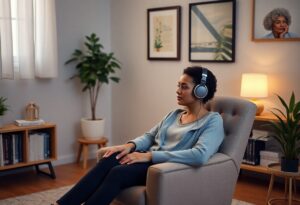Impulse control relates to the ability to resist urges and manage impulsive behaviors, which can be particularly challenging for individuals dealing with impulse control disorders. Your path to improving this aspect of your mental health can be significantly guided by innovative treatments such as Transcranial Magnetic Stimulation (TMS) and neurofeedback. These methods can help enhance your self-regulation and overall emotional balance. To explore more about how therapies like TMS can assist in managing impulsivity, consider reading this study on Repetitive Transcranial Magnetic Stimulation Treating ….

Key Takeaways:
- TMS Therapy: Transcranial Magnetic Stimulation can effectively target brain circuits associated with impulse control, helping to regulate maladaptive behaviors.
- Neurofeedback: This technique enables individuals to learn how to control their brain activity, leading to improved self-regulation and reduced impulsivity.
- Combined Approach: Using TMS alongside neurofeedback may enhance treatment outcomes, providing a comprehensive strategy for managing impulse control disorders.
Understanding Impulse Control Disorders
Definition and Overview
Control issues related to impulse management can significantly affect your life. Impulse Control Disorders (ICDs) are characterized by the inability to resist urges or impulses that can lead to harmful behaviors. These disorders can manifest in several different ways, impacting both mental health and social functioning.
Types of Impulse Control Disorders
Control takes different forms within Impulse Control Disorders. Below are examples of the most notable types:
- Intermittent Explosive Disorder
- Kleptomania
- Pyromania
- Pathological Gambling
- Trichotillomania (Hair-Pulling Disorder)
Assume that each type of disorder presents unique challenges and symptoms, leading to varying degrees of difficulty in your daily life.
| Type | Description |
| Intermittent Explosive Disorder | Characterized by sudden episodes of unwarranted anger. |
| Kleptomania | Involves stealing items that are not needed for personal use. |
| Pyromania | Involves repeated urges to set fires. |
| Pathological Gambling | Characterized by an uncontrollable urge to gamble. |
| Trichotillomania | Involves compulsively pulling out hair. |
Symptoms and Diagnosis
Control over impulsive actions can be difficult, and recognizing symptoms is the first step toward effective management. Common symptoms include intense urges, subsequent feelings of guilt, and a pattern of behaviors that disrupt normal functioning.
Understanding the nuances of these symptoms is necessary for diagnosis. You may find yourself struggling with feelings of remorse after an impulsive act, or you might frequently engage in behaviors that jeopardize your safety and relationships. A professional assessment is necessary for a proper diagnosis to help you navigate these challenges effectively.
Impact on Daily Life
With impulse control disorders, your daily life can be greatly impacted. These disorders can lead to strained relationships, difficulties at work, and challenges in personal growth.
Understanding how these disorders affect your routines is important. You may notice that engaging in impulsive behaviors causes a cycle of regret and shame, further complicating your path to recovery. Support and treatment can provide you with effective strategies to regain control and improve your well-being.
Symptoms of Impulse Control Disorders may vary significantly among individuals, amplifying their effect on your day-to-day experiences. Being aware of the specific actions and emotional responses associated with your disorder can empower you to seek appropriate help. Taking proactive steps toward managing your impulses can lead to a more fruitful and fulfilling life.
Traditional Treatments for Impulse Control Disorders
The treatment options for impulse control disorders often involve a combination of psychotherapy and pharmacological interventions. Understanding these traditional approaches can help you make informed decisions about your path to managing these disorders effectively.
Psychotherapy Approaches
Approaches such as cognitive-behavioral therapy (CBT) and dialectical behavior therapy (DBT) are often employed in treating impulse control disorders. These therapies aim to help you identify triggers for impulsive behavior, develop coping strategies, and replace negative thought patterns with healthier ones.
Pharmacological Interventions
Approaches to pharmacological interventions typically include antidepressants, mood stabilizers, and antipsychotic medications. These medications can help manage symptoms associated with impulse control disorders by targeting the brain’s neurotransmitters, providing relief from overwhelming urges.
Psychotherapy is generally used alongside medication to create a comprehensive treatment plan tailored to your individual needs. While medications can alleviate some symptoms, therapy equips you with practical skills to handle impulses more effectively in daily life.
Limitations of Traditional Treatments
The effectiveness of traditional treatments can vary from person to person, often requiring a period of adjustment to find the right combination of therapy and medication.
Impulse control disorders can be complex, and traditional treatments may not address all underlying issues or provide sufficient relief for everyone. You might find that some methods take time to show results, and side effects from medications can sometimes counteract their benefits, making it crucial to explore alternative options as part of your overall treatment strategy.
Impulse control challenges can significantly affect your daily life and relationships. Fortunately, innovative approaches like Transcranial Magnetic Stimulation (TMS) and neurofeedback offer promising relief. TMS, particularly repetitive TMS on the left cerebellum, affects impulsivity in ways that can reshape your behavior patterns. By incorporating neurofeedback, you can also gain insights into your brain activity, helping you develop better control over your impulses. Exploring these options can empower you on your journey to improved impulse control; learn more about Repetitive TMS on Left Cerebellum Affects Impulsivity in ….
Neurofeedback as a Treatment Modality
Unlike traditional therapeutic methods, neurofeedback offers a unique approach to improving impulse control. By training your brain to regulate its electrical activity, you can develop better control over your impulses and behaviors.
What is Neurofeedback?
To put it simply, neurofeedback is a type of biofeedback that uses real-time displays of brain activity to help you learn self-regulation of brain function. Through various techniques, you can gain insights into your mental states and learn to alter them positively.
The Science Behind Neurofeedback
Among the many therapeutic modalities, neurofeedback stands out due to its focus on brainwave activity. This method uses sensors to measure electrical activity in your brain, offering valuable feedback about your mental states. By employing conditioning techniques, you can train your brain to function more optimally.
Another important aspect of neurofeedback lies in its principles derived from operant conditioning. When you receive feedback about your brain activity, you learn to make adjustments over time, enhancing your ability to regulate unwanted impulses. This learning process can lead to lasting changes in how your brain functions, making it a potent tool for treating impulse control disorders.
Applications for Impulse Control Disorders
About impulse control disorders, neurofeedback can be particularly effective in helping you understand and manage your urges. Through targeted training, you learn to recognize when your impulses arise and employ strategies to mitigate them effectively.
Considering the varied nature of impulse control disorders, neurofeedback’s customizable approach allows for tailored interventions that address your specific challenges. Many individuals have reported improvements in their ability to cope with urges, leading to enhanced overall well-being and decision-making. This personalized treatment offers a promising option for you or anyone struggling with impulse control issues.
Comparing TMS and Neurofeedback
Your understanding of treatment options for impulse control disorders can significantly benefit from a comparison of Transcranial Magnetic Stimulation (TMS) and neurofeedback. Both methods provide unique approaches, and evaluating their features can help you make an informed choice. For a more in-depth discussion on Transcranial Magnetic Stimulation (TMS) Therapy Vs. Neurofeedback, this section will break down the differences between these two therapies.
Comparison of TMS and Neurofeedback
| Transcranial Magnetic Stimulation (TMS) | Neurofeedback |
| A non-invasive procedure that uses magnetic fields to stimulate nerve cells in the brain. | A technique that trains individuals to alter brain activity through real-time feedback. |
| Often conducted in a clinical setting by trained professionals. | Can be done in various settings, including home, with appropriate equipment. |
| Research supports its efficacy in treating disorders like depression. | The effectiveness varies and is often subjective, depending on the individual’s engagement. |
Methodology Differences
Behind the scenes, tms and neurofeedback employ distinct methodologies. TMS utilizes magnetic pulses to directly stimulate regions of the brain associated with impulse control. In contrast, neurofeedback trains you to recognize and modify your brain activity patterns through visual or auditory signals, a more participatory process that encourages personal involvement in your treatment.
Patient Experience and Accessibility
To gain insight into the patient experience and accessibility, consider how TMS and neurofeedback differ. TMS typically requires several clinical sessions, which may not be as accessible for everyone due to location or insurance coverage. Neurofeedback, on the other hand, can be practiced remotely and offers more flexibility regarding training sessions, making it more accessible for individuals looking for at-home options.
Also, accessibility can significantly shape your treatment journey. If you are in a location with limited access to mental health professionals, neurofeedback might offer a viable alternative. The convenience of at-home training makes it an attractive option for many, allowing you to integrate treatment into your daily routine. Conversely, TMS therapy guarantees a controlled, professional environment but requires you to commit to scheduled visits.
Efficacy and Outcomes
Between TMS and neurofeedback, the efficacy and outcomes can vary widely. While TMS has a strong base of supporting research showcasing its effectiveness for specific disorders, neurofeedback has a more varied evidence base, with results often dependent on individual commitment and specific brain training protocols.
Considering your long-term goals is key when evaluating efficacy. TMS offers more immediate, standardized results, primarily due to extensive clinical trials backing its use. Neurofeedback, while still beneficial, may require more time and personal engagement to see significant changes in your impulse control. Tailoring your choice to your needs and circumstances will lead to a more fulfilling treatment experience.
Case Studies and Research Findings
Many studies and clinical cases highlight the effectiveness of Transcranial Magnetic Stimulation (TMS) and Neurofeedback in treating impulse control disorders. The following are some significant findings:
- Case Study 1: A group of 30 patients undergoing TMS treatment showed a 50% reduction in impulsivity scores after 10 sessions.
- Case Study 2: Neurofeedback training in 25 participants resulted in a notable 40% decrease in impulsive behaviors within eight weeks.
- Longitudinal Study: Research over 12 months indicated that 60% of individuals receiving combined TMS and Neurofeedback treatment saw sustained improvement in impulse control.
- Meta-Analysis: A review of 15 studies found TMS to improve impulse regulation by an average of 55%, particularly among individuals with ADHD.
- Randomized Control Trial: In a trial with 50 participants, combined approaches enhanced treatment outcomes by 70% compared to traditional therapies alone.
Case Study 1: TMS and Impulse Control
Research has demonstrated the benefits of TMS in managing impulsive actions. A clinical trial involving 30 participants revealed a significant 50% decrease in impulsivity after a series of TMS sessions, showcasing how targeted brain stimulation can effectively rewire neural pathways related to impulse control.
Case Study 2: Neurofeedback in Practice
Behind the scenes, Neurofeedback has been proving its mettle in altering brainwave patterns associated with impulsive behavior. In a recent case, 25 participants engaged in Neurofeedback sessions experienced a 40% reduction in impulse-control-related disorders, traing their brains to foster healthier responses over time.
Also, it’s important to note that this particular approach empowers you by allowing real-time feedback on your brain activity. Participants learn to adjust their mental states to achieve desired outcomes, promoting self-regulation and long-term behavioral improvement.
Recent Research on Combined Approaches
About blending TMS and Neurofeedback, recent studies indicate that using these two therapies in conjunction can lead to remarkable outcomes. In a study, participants receiving both treatments showed a 70% improvement rate in impulse control issues, significantly more than those undergoing only single-modality treatments.
Hence, integrating both modalities capitalizes on their synergistic effects, providing you with a comprehensive approach to managing impulse control disorders. This combined strategy not only amplifies the efficacy of individual treatments but also cultivates a more profound, lasting change in impulse regulation.

Future Directions in Treatment
Now, as we explore the future of treating impulse control disorders, it’s crucial to consider innovative approaches that enhance efficacy and accessibility. Advances in technology and personalized medicine are on the horizon, offering new pathways for recovery and self-regulation.
Emerging Technologies in Mental Health
An exciting area of development in mental health is the emergence of digital tools like mobile apps and virtual reality therapies. These technologies can provide immediate support, allowing you to practice impulse control strategies in real-time, thereby fostering resilience and skill-building.
Personalized Treatment Plans
Above all, personalized treatment plans are becoming increasingly vital in addressing the unique needs of each individual experiencing impulse control disorders. Tailoring interventions to align with your specific emotional, cognitive, and physiological profiles can significantly enhance the effectiveness of your treatment journey.
Treatment plans that incorporate variables such as your personal history, preferences, and feedback can optimize the therapeutic experience. You may find that strategies like transcranial magnetic stimulation (TMS) or neurofeedback are adapted to fit your responses, ensuring that the support you receive aligns with your progress and challenges. This individualized approach paves the way for more engaged participation and improved outcomes.
The Role of Biopsychosocial Models in Treatment
Biopsychosocial models emphasize the interplay of biological, psychological, and social factors in mental health treatment. Understanding this interconnectedness can help you address the root causes of your impulse control issues and develop more holistic strategies for managing them.
Hence, integrating these models into your treatment can provide a comprehensive view of how different aspects of your life affect your behavior. By considering not just the neurological and emotional components, but also the social context, you can better navigate the complexities of impulse control disorders. This multi-faceted perspective allows for more effective interventions, as it recognizes the importance of your environment and relationships in your healing journey.
Final Words
Conclusively, TMS and neurofeedback offer promising avenues for managing impulse control disorders, helping you regain control over your actions and enhance your emotional regulation. By targeting specific brain regions, TMS can facilitate change in your neural pathways, while neurofeedback empowers you to train your brain for improved self-control. Engaging in these evidence-based therapies may lead to more positive behavioral outcomes, enabling you to navigate life with greater confidence and stability.
FAQ
Q: What are impulse control disorders and how do they manifest?
A: Impulse control disorders are a group of psychiatric conditions characterized by the inability to resist urges or impulses that can lead to harmful or undesirable outcomes. These disorders may include kleptomania, pyromania, and intermittent explosive disorder, among others. Individuals may experience overwhelming urges to engage in behaviors that are detrimental to themselves or others, leading to significant distress and impairment in social, occupational, or other areas of functioning.
Q: How does Transcranial Magnetic Stimulation (TMS) work in treating impulse control disorders?
A: TMS is a non-invasive treatment that uses magnetic fields to stimulate nerve cells in specific areas of the brain. By targeting regions associated with impulse control, such as the prefrontal cortex, TMS can help balance brain activity and improve emotional regulation. This modulation can reduce the frequency and intensity of impulsive behaviors, contributing to better overall control and decision-making.
Q: What role does neurofeedback play in improving impulse control?
A: Neurofeedback is a therapeutic technique that involves training individuals to alter their brainwave patterns through real-time feedback. For impulse control disorders, neurofeedback aims to enhance self-regulation and emotional stability by teaching patients to increase activity in brain areas linked to impulse management. Over time, this can lead to improved cognitive control and a reduction in impulsive behaviors.
Q: Are TMS and neurofeedback effective on their own or should they be combined with other treatments?
A: While both TMS and neurofeedback can provide significant benefits for impulse control disorders, research supports their combined use with psychotherapy or medication for optimal outcomes. Combining different therapies allows individuals to address underlying psychological issues, enhance coping strategies, and develop healthier behavior patterns, leading to a more comprehensive treatment approach.
Q: What should a person expect during TMS and neurofeedback treatment sessions?
A: During TMS sessions, individuals typically sit in a comfortable chair while a device delivers magnetic pulses to targeted brain areas. Sessions usually last around 20 to 40 minutes, with patients experiencing minimal discomfort. In neurofeedback sessions, patients engage in activities that monitor and provide feedback on their brain activity, often through games or visual displays. Each session is designed to be engaging and informative, allowing individuals to track their progress over time.







